Brake pads should be thicker than 6.4 mm ( around ¼ inches) for proper functioning and safety measures. Most mechanics will answer the question of what is the wear limit on brake pads should be around 3 mm or 1/8″. You should seriously consider getting your pads replaced soon if they are thinner than this.
Contents
- 1 What Are the Wear Limits on Brake Pads?
- 2 A Comprehensive Guide to Inspecting Brake Pad Thickness
- 3 Uneven Brake Pad Wear Left Right
- 4 Worn Brake Pads Symptoms
- 5 What Is the Legal Limit for Brake Pads?
- 6 At What Thickness Should Brake Pads Be Replaced?
- 7 FAQ
- 8 Conclusion – What is the Wear Limit on Brake Pads
What Are the Wear Limits on Brake Pads?
Brake pads are a segment of disc brakes used in automotive and other uses. Composed of steel backing plates, brake pads convert the kinetic energy of the vehicle to thermal energy through friction
Most of the mechanics and manufacturers have suggested and agreed that the approximate wear limit to the brake pads is 3 mm. Almost all of the new brake pads available in the market are around 8-12 mm thicker. Usually, your brake pads need to be thicker than 6.4 mm, so that they can function properly. Many modern vehicles are provided with wear indicators to warn drivers when replacement is needed because of thin brake pads.
Changing the brake pads before it reaches their wear limits stops the vehicle from brake failure and future accidents. So, it is important to know the wear limit on the brake pads that you’re using.
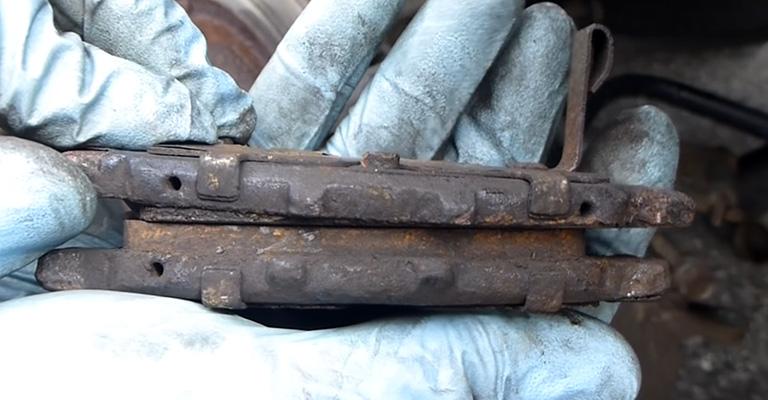
A Comprehensive Guide to Inspecting Brake Pad Thickness
As responsible drivers, we need to maintain all aspects of our vehicles to ensure safety on the roads. One crucial component of vehicular maintenance is routinely checking the thickness of brake pads. The brake pads are vital parts of the braking system, providing the friction needed to slow or stop your vehicle. Over time, they wear down and need replacing to ensure optimal vehicle performance and safety.
What You’ll Need
Before we delve into the steps of inspecting brake pad thickness, you’ll need a few tools and items:
- Flashlight or torch.
- Measuring tool (like a vernier caliper or ruler).
- Vehicle’s owner manual.
Let’s break down the steps on how to inspect brake pad thickness:
1. Locate the Brake Pads
Start by locating the brake pads through the wheel spokes. Depending on your vehicle, you might be able to see them without removing the wheel. You will see the brake rotor (a large, round metal disc), and the brake pads are located on either side of it. The outside pad will be pressed against the rotor.
2. Inspect Visually
Using your flashlight, inspect the brake pads visually through the wheel spokes. The outer pad is pressed against the brake rotor, and you should be able to see it fairly clearly. The part of the pad that you can see should look thick, indicating that it’s still in good condition.
3. Measure the Brake Pad Thickness
Next, use a tool like a vernier caliper to measure the thickness of the brake pad if you can reach it without removing the wheel. However, a ruler can be used in a pinch. As a guideline, a new brake pad usually has 10-12 millimeters of thickness. If your pads are 3 millimeters or less, it’s generally time to replace them.
4. Check the Wear Indicator
Some brake pads have a built-in wear indicator. This is usually a small metal piece that contacts the brake disc when the pad material has worn down to a certain point. If you see the wear indicator or hear a squealing noise when braking, it’s a sign that your brake pads need replacing.
5. Consult Your Vehicle’s Owner’s Manual
Lastly, always refer to your vehicle’s owner’s manual for manufacturer-specific information. Different manufacturers and models have different specs, so the manual can provide a more precise brake pad thickness limit for your specific vehicle.
When to Replace Your Brake Pads
Although visual inspections can give you an idea of when it’s time to replace your brake pads, many factors can influence their lifespan. For example, aggressive driving or frequent driving in heavy traffic can wear out brake pads more quickly. It’s best to have your brake pads inspected by a professional mechanic at regular intervals, such as when you get an oil change.
Remember, brakes are the most critical safety feature on your car. If you’re unsure about the condition of your brake pads, it’s always better to consult a professional. Good maintenance habits, including regular inspections of your brake pad thickness, can help ensure your vehicle operates safely and smoothly.
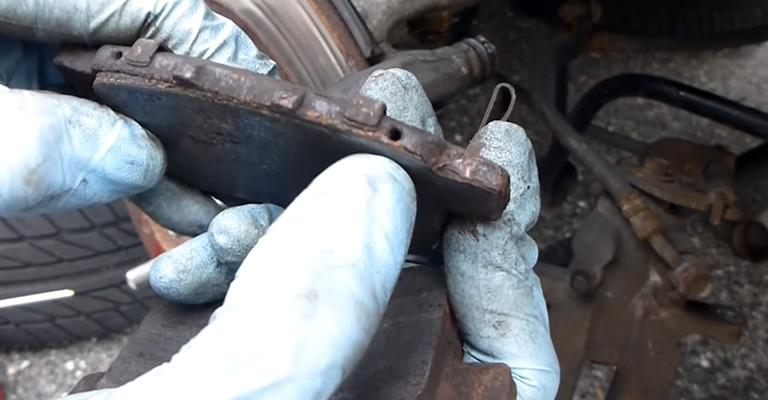
Uneven Brake Pad Wear Left Right
DTV or Disc Thickness Variation is the most common cause of unevenly worn brake pads. If your disc has any small difference in thickness, the brake pads will wear down differently over time. And if there is any difference, the thinner parts of the discs will slip through the brake pads easily, where the thicker parts will not.
There is a precaution you can follow when installing brake rotors or discs by yourself, that is using brake cleaners to wipe off the dirt of the surfaces.
Brake calipers are also a reason for uneven brake pads. The guide pins of the calipers sometimes cause the brakes to drag along the rotor when brakes are not being applied. You can get them greased or replaced by your mechanic.
Worn Brake Pads Symptoms
Some worn brake pads symptoms to watch out for:
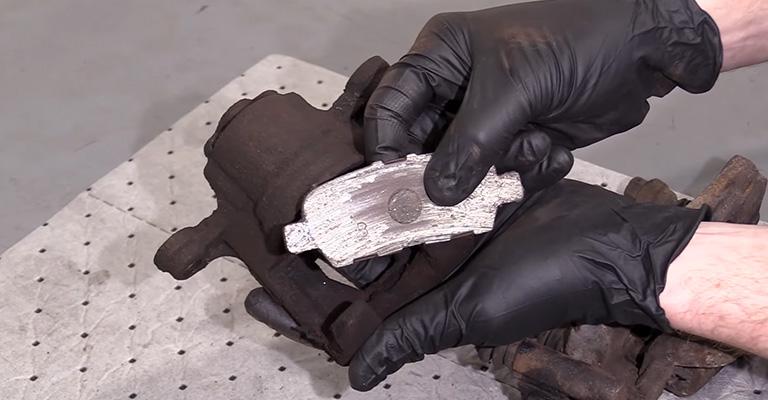
Making noise
When brake pads get worn out, it starts accumulating a lot of dust on the rotor. The continuous dust accumulation will occur in squealing noises when you press on the brake pedal. As brake pads are created from friction material, this friction material creates dust.
Indicator Warning
This feature is available on new model modern high-end vehicles. There is an indicator light that lets you know when to change your brake pads. There are two sensors, one is on the friction material which creates a signal when making a contact with the brake rotor. The other one is a position sensor that calculates the amount of the pedals that have to move before the brakes are applied.
Slow response
If the brake pads are worn out and you press the brake pedal, it won’t react quick enough. The brake pads will become unable to create enough friction with rotors within time. This might cause serious accidents.
Burning smell
If while driving you smell burning when pressing the pedals, it is because the pads are overheated. Pullover the car immediately to check. And if someone is unable to cool off that heat, the brake fluid might heat up to the boiling point which might lead to brake failure. If you see smoke coming out of that tire, it might be a brake caliper stuck and it’s very unsafe driving with it.
Vibrations
When pressing pedals if you feel a vibration, it might be either because of bad brake pads or brake rotors. This vibration is caused by the brake pad touching the rotor. If either one of them is damaged, it will keep happening.
What Is the Legal Limit for Brake Pads?
The legal limit or the safe MM for brake pads is approximately 3 mm. If your brake pad thickness is 1.5 mm or less you should change your pads immediately. Though most of the mechanics will recommend you change your brake pads if they are worn down to 3 mm. Anything less than 3 mm will expose the metal sensor making contact with the brake disc.
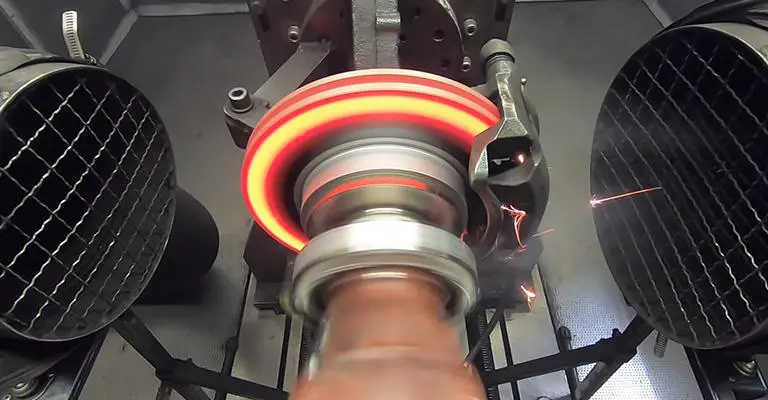
At What Thickness Should Brake Pads Be Replaced?
The ideal thickness for your brake pads to work functionally is more than 6.4 mm. But if the brake pads are thinner than this, you need to consider getting them replaced. Up to 6.4 mm thick brake pads are very functional for brake pads. 3 mm is the legal limit for the brake pads to get replaced. If it’s less than 3 mm, you need to replace them immediately.
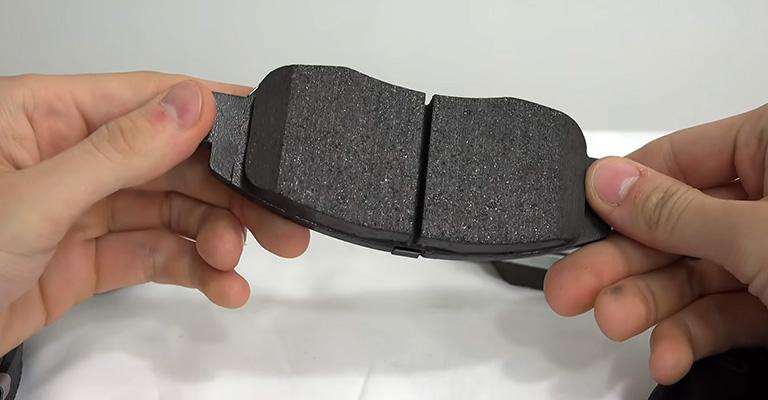
FAQ
How thick should brake pads be?
New brake pads usually have around 12 millimeters of thickness. As they wear down with use, they get thinner. If they reach a thickness of 3 millimeters or less, they should be replaced. Brake pads at this thickness are nearing the end of their lifespan and may not work effectively.
What happens if you ignore the wear limit on brake pads?
Ignoring the wear limit on brake pads is dangerous and can lead to brake failure. As the brake pads become excessively worn, the braking system’s effectiveness decreases, potentially causing longer stopping distances and even total brake failure. Furthermore, worn brake pads can damage other parts of the brake system, like the rotors and calipers, leading to expensive repairs.
How can I check the wear limit on my brake pads?
You can check the thickness of your brake pads through the wheel spokes – the outside brake pad will be pressed against the brake rotor. There should be at least 1/4 inch of pad. If there’s less than that, you should get the brake pads inspected or replaced. However, some brake pads have wear indicators that make a high-pitched warning sound when the brake pads are too thin. If you hear this sound, it’s time to replace your brake pads.
Can you drive with worn brake pads?
It’s possible to drive with worn brake pads, but it’s not safe or recommended. As brake pads wear down, they become less effective at slowing or stopping your vehicle. This can lead to longer stopping distances, poor brake performance, and even brake failure. If you suspect your brake pads are worn beyond their limit, you should have them replaced immediately.
How often should brake pads be replaced?
The frequency at which brake pads should be replaced depends largely on your driving habits, the type of vehicle you have, and the type of brake pads used. However, a general rule of thumb is to replace them every 50,000 miles. Some vehicles may need new pads after only 25,000 miles, while others can go up to 70,000 miles. Always refer to your vehicle’s owner manual and consult a professional mechanic for advice specific to your situation.
Conclusion – What is the Wear Limit on Brake Pads
Brake pads are an essential part of your car’s braking system. They help to slow down and stop your car by creating friction between the pads and the brake rotors. Over time, brake pads will wear down and need to be replaced.
The wear limit for brake pads varies depending on the manufacturer, but most agree that they should be replaced once they reach 3mm thick. This is because the brake pads will not be able to provide adequate stopping power once they get below this thickness.
There are a few ways to know when your brake pads are worn. One way is to check the thickness of the pads. You can do this by removing the wheel and looking at the pads. If the pads are less than 3mm thick, they should be replaced.
Another way to know when your brake pads are worn is to listen for a squealing noise when you brake. This noise is caused by the pads rubbing against the rotors. If you hear a squealing noise, it’s a good idea to have your brake pads checked.
The frequency with which you need to replace your brake pads depends on a number of factors, including your driving habits and the type of car you drive. However, most experts recommend replacing your brake pads every 30,000 to 60,000 miles.
If you drive in a lot of stop-and-go traffic or if you tow heavy loads, you may need to replace your brake pads more often.
The cost of replacing brake pads varies depending on the make and model of your car, as well as the labor rates in your area. However, you can expect to pay anywhere from $50 to $200 per axle.
It’s important to replace your brake pads when they are worn down to the wear limit. If you wait too long, you may experience longer stopping distances, a spongy or mushy brake pedal, or vibrations when you brake. These symptoms can be dangerous and can lead to accidents.
Replacing your brake pads is a relatively simple and inexpensive repair. It’s a good idea to have your brake pads checked every time you have your car serviced. This will help to ensure that your brakes are working properly and that you are safe on the road.
Additional tips for extending the life of your brake pads:
- Avoid hard braking.
- Accelerate and brake smoothly.
- Inspect your brake pads regularly.
- Replace your brake pads as soon as they start to show signs of wear.
By following these tips, you can help to extend the life of your brake pads and keep your car safe on the road.
